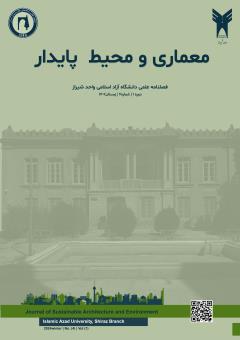Investigating the impact of the smart skin according to the location of the user on the amount of energy consumption in cold climate office use (case example of Tabriz city)
Subject Areas : َArchitecturezohre salavati 1 , majid shahbazi 2 * , Zohreh Tarabi 3
1 - Architecture and Urban Planning, Technical and Engineering Faculty, Zanjan Branch, Islamic Azad University, Zanjan, Iran
2 - Department of Architecture and Urban Planning, Technical and Engineering Faculty, Zanjan Branch, Islamic Azad University, Zanjan, Iran
3 - Department of Architecture and Urban Planning, Technical and Engineering Faculty, Zanjan Branch, Islamic Azad University, Zanjan, Iran
Keywords: Smart skin, energy consumption, cold climate,
Abstract :
The shell of the building is one of the most key components of the building. Windows, which are part of the building shell, can play a significant role in reducing energy consumption and increasing the efficiency of natural lighting, which increases the health of the environment and users. But this does not mean that natural lighting will always reduce energy consumption, but it depends on many parameters. Today, the use of smart and moving facades to improve the light received by residents is known as an effective solution. In this research, the effect of smart facades on the amount of energy consumption in an office room in a cold climate has been investigated. In this research, the goal of the researchers is not to design a shell, but to provide a parametric method to reduce energy consumption. Therefore, the effectiveness or not of this method compared to its traditional mode, i.e. using curtains, has been evaluated. For this purpose, 5 different modes without curtain, closed curtain and three smart shell modes which are arranged in different types have been done. The results show that in the proposed modes of the smart shell, the energy consumption on the south and east fronts has improved by 40% and 65%, respectively, compared to the mode with curtains.
منابع تصاویر:
شکل 1 :فرآیندکاری پژوهش (منبع: نگارندگان).
شکل 2: چیدمانهای مختلف در تحقیق حاضر. تصویر سمت راست: چیدمان T، تصویر وسط: چیدمان موازی ll، تصویر سمت چپ: چیدمان U
(منبع: نگارندگان).
نمودار 1: ضریب تعیین بر اساس میانگین دمای هوای ماهیانه
نمودار 2: مقایسه مصرف انرژی در حالت های مختلف در دو جهت شرق و جنوب
نمودار 3: مقایسه مصرف انرژی در حالت های مختلف در جبهه جنوب
نمودار 4: مقایسه مصرف انرژی در حالت چیدمانی U، T و موازی (ll) با حالت های بدون پرده و با پرده بسته در جبهه جنوب
نمودار 5: مقایسه مصرف انرژی در حالت های مختلف در جبه شرق
نمودار 6: مقایسه مصرف انرژی در حالت چیدمانی U، T و موازی (ll) با حالت های بدون پرده و با پرده بسته در جبهه شرق

